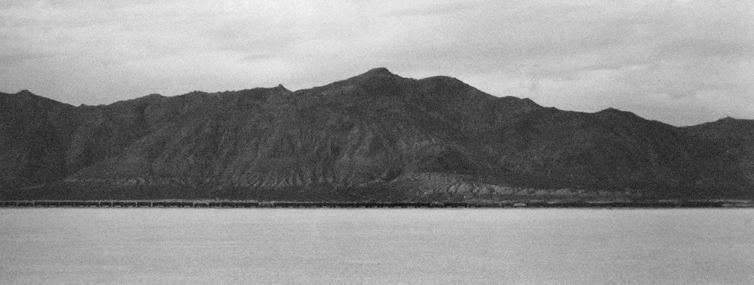Meditation on Mountains and Deserts
Gray Tolhurst
3/6/2013


Photography and cinema occupy a unique space within the sphere of art. Take a mountain for example: one can write a poem about a mountain or paint a mountain that they have only heard about or seen second-hand. A painting or a poem with a mountain as a subject is detached from the reality of the mountain itself. However, if one makes a film about a mountain, they have to live by or travel to, the mountain. The nature of film is contradictory requiring both an attachment to reality and the image captured and a “willful suspension of disbelief” (Coleridge 1817).
Walter De Maria’s Hard Core is a visual exploration of the desolated landscapes of Nevada’s Black Rock Desert. The film’s central attraction in its twenty-nine minute duration are a number of spectacular 360-degree panoramic shot of the cracked desert earth, ringed by distant mountains.. The film lures the viewer into a trance, broken only by periodic flashes of a stereotypical cowboy loading his revolver under the sweltering sun. The film blurs the line between cinematic storytelling and the abstract, between the western and the nature film.
Hard Core can be seen as a non-traditional documentary, unconstrained by the restrictions of narration and chronology. Hard Core eschews most of the character and plot development and suspense that characterize a narrative film or even a traditional documentary (Nichols 2001). It does, however, retain the barest threads of a plot, illustrated by the rapid cuts to the gunfight. A documentary documents but also analyzes and while De Maria does not include any narrative, title cards, or dialogue, the juxtaposition of the serene desert and the frenetic gunfight reflects on man’s intrusion into, and destruction of, the natural environment. The landscape is no longer the subject but more of a meditational object like prayer beads or a gong. The self-contained works of art but also functions as a tool for further exploration of the psyche. The rapid flashes of what is seemingly a traditional Old West gunfight serve to disrupt the meditative nature of the film.
Perhaps one of the most unique elements of cinema is the synchronization of visual and aural stimuli. Music and sound design within a film serve to highlight and underscore the images and plot detail. Hard Core is accompanied by two pieces of music also by De Maria, “Cricket Music” (1964) and “Ocean Music” (1969). “Ocean Music” is a roaring, cataclysmic field recording of the sea, that set against the silent desert background of Hard Core, creates a sense of rising tension as it builds in volume; broken only by lapses of silence as the gunslingers load their weapons and take aim The oppressive sounds of the ocean then give way to a piece of frenetic drumming and cymbal work called, “Cricket Music.” It seemed out of place and almost inappropriate as the soundtrack of the setting desert sunset. The challenging aural landscape of Hard Core acts as the antithesis to its serene physical landscape. At its best the film is entrancing, and soporific at worst. Hard Core wavers between documentary, nature film, and an avant-garde exercise in camera work, never hovering too long on one concept. Just as the camera pans between mountain and cactus, always moving, the nature and intention of the film is illusory.
The film screened at LACMA in conjunction with De Maria’s installation the 2000 Sculpture which is on view in the museum’s Resnick Pavillion.
